Symbolism in Chinese and Japanese Gardens
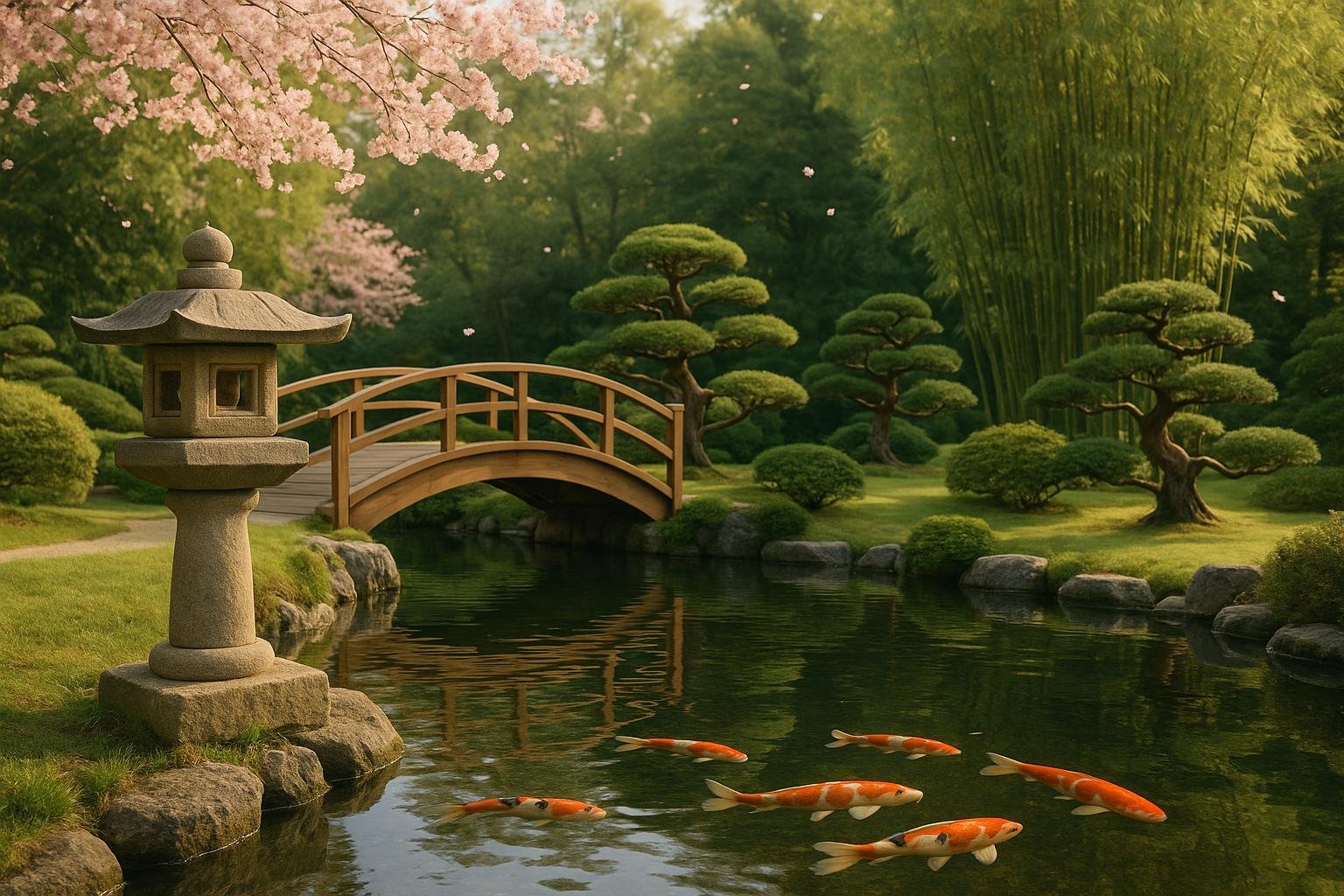
Chinese and Japanese gardens are more than beautiful spaces - they are reflections of deep philosophies. Every element, from rocks to plants, holds symbolic meaning, aiming to create harmony and inspire meditation. While Chinese gardens focus on natural landscapes and the balance of Yin and Yang, Japanese Zen gardens emphasize simplicity and mindfulness.
Key Differences:
- Chinese Gardens: Inspired by Taoism, they mirror natural landscapes with water, rocks, and plants symbolizing harmony.
- Japanese Zen Gardens: Rooted in Zen Buddhism, they use minimal elements like stones and raked gravel for meditation and reflection.
Quick Comparison:
| Aspect | Chinese Gardens | Japanese Zen Gardens |
|---|---|---|
| Philosophy | Taoism (Yin-Yang balance) | Zen Buddhism (mindfulness) |
| Water Features | Ponds and streams | Represented by raked gravel |
| Stone Use | Dramatic, weathered stones | Simple, balanced arrangements |
| Plant Selection | Symbolic, natural growth | Sculpted, evergreen focus |
| Viewing Style | Multiple paths and perspectives | Single viewpoint for contemplation |
Modern designers can incorporate these elements into local landscapes by focusing on the symbolic intent, using native materials, and creating tranquil spaces for reflection. Tools like AIGardenPlanner make it easier to design gardens inspired by these timeless principles.
Oriental Garden – Chinese garden and Japanese garden

Symbolic Elements in Chinese Gardens
Chinese gardens transform everyday features into rich symbols, perfected over three thousand years to craft idealized miniature landscapes [2].
Key Features: Rocks, Water, and Plants
At the heart of Chinese garden design are five key elements: water, plants, miniature architecture, rocks, and decorative screens or windows [1].
Rocks play a central role, symbolizing mountains, stability, and endurance [1]. They embody Yang, the masculine force, and are often arranged to mimic miniature mountain ranges or frame water features [1]. Among these, limestone from Lake Tai is especially valued for its weathered, intricate shapes [1].
Water represents life, dreams, and infinity [1][4]. As the Yin counterpart to rocks, it brings balance to the garden. Ponds and streams are designed to flow naturally, evoking a sense of vitality and movement [1].
Plants convey profound meanings, with each species chosen for its symbolic resonance. Pine trees, for example, represent longevity and steadfastness. Confucius once remarked:
When the year turns cold, pines and cypresses reveal their persistent green [3].
Bamboo, a symbol of integrity and humility, inspired poet Su Shi to write:
It is better to eat without meat than to live without bamboo [3].
Plum blossoms signify resilience. As poet Lu You described:
The plum will not compete with other flowers in spring, and let those flowers envy each other [3]. Ground to dust and scattered into the mud, her fragrance is still the same [3].
Chrysanthemums stand for courage and nobility, captured beautifully by Tao Yuanming:
Chrysanthemums blossom and shine in the woods; green pines are lining on the rocks. The flower can be considered a hero standing straight even when covered with frost [3].
Lastly, the lotus symbolizes purity, rising untouched from muddy waters [1].
These elements are deeply rooted in philosophy and mythology, giving them layers of meaning that go beyond their physical presence.
Taoist and Mythological Influences
Taoist philosophy heavily informs Chinese garden design, emphasizing harmony with nature and the exploration of the Tao [7]. The balance of Yin and Yang is central here - Yin representing water, darkness, and softness, while Yang symbolizes mountains, stone, daylight, and strength [1].
The concept of wu wei (non-action) encourages designers to capture nature’s essence rather than forcefully recreating it [7]. Laozi articulated this beautifully:
The earth moves according to nature, the saints act upon nature, and nature is Tao [7].
Mythology also plays a key role. The legend of Mount Penglai, the mythical home of the Eight Immortals, has inspired garden design for over two millennia. According to the Shan Hai Jing (Classic of Mountains and Seas), Mount Penglai was located on one of three islands in the Bohai Sea [6]. Emperor Qin Shi Huang, in 221 BC, sought to recreate this paradise by constructing a garden with a large lake and an island representing Mount Penglai near his palace at Xianyang [6].
Taoist garden design often leans on subtlety and suggestion, inviting quiet reflection. Poet Yan Yu captured this spirit:
It would be like the sound in the air, the color in the image, the moon in the water, and the image in the mirror, which all tell much more than they reveal [7].
These philosophical and mythical foundations influence not just the elements within the garden but also the way they are arranged.
Design Approach: Winding Paths and Layered Landscapes
Chinese gardens are designed to evoke a sense of discovery through winding paths and layered landscapes [2]. Instead of rigid geometric patterns, they favor an organic flow. Ji Cheng, a renowned garden designer, advised hiding the mundane and highlighting the exceptional.
The technique of "borrowed scenery" (Jiejing) extends the garden’s boundaries by incorporating views from outside its walls [5]. Jean Denis Attiret, a Jesuit priest and court painter for the Qianlong Emperor, described this approach as a "beautiful disorder" and noted:
One admires the art with which this irregularity is carried out. Everything is in good taste, and so well arranged, that there is not a single view from which all the beauty can be seen; you have to see it piece by piece.
This intentional fragmentation encourages visitors to explore the garden’s beauty gradually, revealing its story in layers. During the Song Dynasty (960–1279 CE), as gardens became accessible to a broader audience, this approach gained popularity, solidifying its place in Chinese tradition [1].
Symbolic Elements in Japanese Zen and Meditation Gardens
Japanese Zen gardens, known as karesansui, are designed to create serene, minimalist landscapes that encourage meditation and mindfulness. Stripping away elaborate designs, these gardens rely on simplicity to convey profound meaning. Through the use of a few carefully chosen elements, they transform ordinary materials into symbols of deep reflection. This approach offers a striking contrast to the more intricate symbolism often found in Chinese gardens, providing a unique perspective on garden philosophies.
Core Elements: Stones, Gravel, and Plants
Zen gardens revolve around three key elements - stones, gravel (or sand), and plants. Each component serves a symbolic purpose, representing aspects of nature in an abstract way.
Stones, the backbone of Zen garden design, often symbolize mountains, islands, or mythological figures. Their placement is deliberate and restrained, reflecting a sense of balance and contemplation. A famous example is the Ryoan-ji garden in Kyoto, where fifteen stones are arranged in a sea of raked white gravel. Intriguingly, no matter where you stand, only fourteen stones are visible at once. This subtle design choice embodies the Buddhist teaching that perfection is unattainable, encouraging viewers to reflect on what lies beyond their immediate perception.
Some stone arrangements also tell stories. For instance, certain gardens feature stones positioned to depict a mother tiger carrying her cubs across a river, while others evoke celestial imagery, like the Pleiades star cluster [8].
Gravel or sand represents the flowing elements of nature. Meticulously raked into patterns, it mimics rivers, oceans, or the continuous flow of life. This practice aligns with the Buddhist concept of impermanence, reminding us that change is constant. Traditional Japanese garden manuals, such as the Sakuteiki, even suggest specific directions for raking patterns, with westward flows symbolizing purification and the Buddhist paradise [8].
Plants, particularly moss, add a sense of grounding and continuity. Moss, with its enduring and tranquil qualities, symbolizes the passage of time and resilience. Unlike Chinese gardens, which often highlight seasonal changes, Zen gardens favor evergreens and subtle plantings that maintain their meditative atmosphere year-round.
Zen Philosophical Foundations
Every element in a Zen garden reflects Buddhist principles like simplicity, impermanence, and the pursuit of enlightenment. The design's minimalist approach eliminates distractions, fostering a space for mindfulness.
The concept of wabi-sabi - finding beauty in imperfection - is central to Zen garden aesthetics. Stones are arranged asymmetrically, moss grows naturally, and raked gravel patterns acknowledge their transient nature. Another key principle is ma, or empty space, which emphasizes the importance of silence and potential. This intentional emptiness invites reflection and reinforces mindfulness. The interplay between stone and gravel also hints at the balance of opposites, such as yin and yang, suggesting that harmony comes from complementing contrasts.
Contemplation Gardens: Single Viewing Points
A hallmark of Zen gardens is their design for contemplation from a single vantage point, rather than physical exploration. These gardens are meant to be observed, often from a temple veranda or other designated spot, where the viewer can focus entirely on the scene before them.
Take the Ryoan-ji garden, for example. Visitors are invited to sit quietly and observe its carefully arranged composition, using the garden as a tool for mindfulness and meditation. Historically, such gardens were integral to monastic life, where monks began their day in silent reflection before engaging in their daily routines.
Some Zen gardens also incorporate sound to enhance the meditative experience. The shishi-odoshi - a bamboo water fountain that fills and tips rhythmically - adds an auditory layer to the environment. Its steady, cyclical sound mirrors the rhythms of nature, deepening the sensory and symbolic experience.
| Element | Symbolic Meaning | Design Purpose |
|---|---|---|
| Stones | Mountains, eternity, stability | Serve as focal points for meditation |
| Raked Gravel | Water, impermanence, life's flow | Evoke the ever-changing rhythm of nature |
| Moss/Plants | Endurance, tranquility, time | Provide grounding and continuity |
| Single Viewpoint | Focused contemplation | Eliminate distractions, deepen mindfulness |
| Empty Space (Ma) | Silence, peace, potential | Invite reflective stillness |
🚀 Ready to Reinvent Your Garden?
Join thousands of homeowners who have transformed their gardens using our AI design tool. Upload one photo to explore endless possibilities.
Get your AI garden designs →Comparison of Chinese and Japanese Garden Symbolism
Chinese and Japanese gardens, while both deeply symbolic, reflect distinct philosophies and cultural values in their designs. Chinese gardens draw inspiration from Taoist principles, emphasizing harmony with nature and the balance of opposites, such as yin and yang. These spaces are crafted to offer relaxation and a connection to the natural world, serving as sanctuaries where visitors can escape the hustle of daily life. On the other hand, Japanese gardens are rooted in Zen Buddhism and Shinto traditions, focusing on meditation, cultural appreciation, and achieving inner peace through quiet contemplation.
Key Differences in Symbolism and Design
The symbolic and design choices in these gardens stem from their philosophical roots. Chinese gardens invite exploration through winding paths and hidden views, reflecting the Taoist belief in life's constant flow and transformation. This dynamic layout encourages visitors to discover the garden's beauty from multiple perspectives.
In contrast, Japanese gardens, particularly Zen gardens, are designed around simplicity and stillness. With a single viewing point often at the center, these gardens promote mindfulness and presence, aligning with Zen principles of meditation and quiet observation.
Use of Water Elements
Water plays a significant role in both styles but is represented differently. Chinese gardens feature expansive ponds and lakes, symbolizing life's continuous flow and the balance of opposites. In Japanese gardens, water is often abstracted, represented by raked gravel or carefully placed stones, encouraging viewers to reflect on the essence of water without its physical presence.
Stone Selection and Arrangement
Stones are another key element where the two styles diverge. Chinese gardens often showcase unique stones, such as weathered limestone or sandstone, that stand out as dramatic focal points. These stones reflect the Taoist ideal of balance and natural beauty.
Japanese gardens, however, take a subtler approach. Smooth, dense stones like granite are arranged in asymmetrical groupings that blend seamlessly with the surrounding landscape. This understated design fosters quiet introspection rather than bold visual impact.
Plant Selection and Maintenance
The treatment of plants further highlights the differences in aesthetic philosophy. Chinese gardens prioritize the symbolic meaning of plants, allowing them to grow naturally with minimal pruning. In contrast, Japanese gardens focus on meticulous pruning and shaping, creating an idealized and abstract beauty that enhances their meditative atmosphere.
| Aspect | Chinese Gardens | Japanese Gardens |
|---|---|---|
| Primary Purpose | Relaxation and enjoyment of nature [9] | Meditation and cultural appreciation [9] |
| Philosophical Foundation | Taoism (Yin and Yang balance) | Zen Buddhism and Shinto |
| Overall Aesthetic | Bold, ornamental, and exotic [10] | Minimalist, subdued, and austere [10] |
| Viewing Experience | Multiple viewpoints, exploration [12] | Single viewpoint, contemplation [12] |
| Water Features | Prominent ponds and lakes [10] | Represented through gravel or stones [10] |
| Stone Treatment | Distinctive, individually showcased [10] | Asymmetric, harmoniously arranged [10] |
| Plant Approach | Natural growth, symbolic focus [12] | Sculpted, abstract beauty [12] |
| Architectural Elements | Curved roofs, colorful designs [12] | Straight lines, natural materials [12] |
| Landscape Inspiration | Inland mountains and lakes [12] | Coastal scenes and beaches [12] |
Architectural Integration
Architecture plays a vital role in reinforcing the themes of each garden style. Chinese gardens incorporate elaborate pavilions and pagodas with curved roofs, offering framed views that emphasize the interplay of man-made and natural elements. Meanwhile, Japanese gardens favor simpler structures made from natural materials, with straight rooflines that blend harmoniously into the environment.
These contrasts not only reflect differing cultural philosophies but also offer timeless lessons for modern landscape design. By understanding these symbolic elements, designers today can draw inspiration for creating meaningful and serene outdoor spaces.
sbb-itb-4d6a8dd
Adding Symbolic Elements to Modern Garden Design
Incorporating the timeless symbolism of Chinese and Japanese gardens into modern American landscapes takes a thoughtful approach. It's not about copying exact designs but understanding the deeper meanings behind these elements and reimagining them using local materials, climate conditions, and cultural preferences. This approach ensures that the essence of these ancient traditions can thrive in contemporary settings.
For homeowners, this means focusing on the symbolic intent of each garden feature. A small backyard water feature, for instance, can evoke the tranquility of a traditional pond, while locally sourced stones arranged with care can symbolize mountains and islands just as effectively as imported ones.
Adapting Symbolism for Local Climates and Materials
The principles outlined in the Sakuteiki provide valuable guidance for adapting traditional garden symbolism to modern contexts. These principles emphasize harmony with the environment, reflecting local scenic beauty, and using materials and elements that resonate with the region.
Working with Local Water Features
Water has long symbolized calm, continuity, and wonder in Chinese and Japanese garden traditions [11][17]. In American gardens, a rain garden that collects runoff can embody the idea of water's flow, while a small reflecting pool or even a birdbath can capture the serene, meditative quality of still water [14].
In areas where water conservation is a concern, dry creek beds made with local river rocks can suggest the presence of water without requiring a constant flow. This approach adapts traditional water symbolism to meet modern environmental challenges [15].
Selecting Regional Stone Elements
In traditional gardens, rocks represent stability, with vertical stones symbolizing mountains and flat ones evoking islands [14][11]. Instead of importing stones, consider using materials native to your region. For example, New England fieldstone can echo the permanence of classic Chinese designs, while desert sandstone in the Southwest, with its natural weathering, speaks to resilience. In Colorado, granite boulders can stand in for mountain peaks.
By choosing stones that reflect your local environment, you not only enhance the symbolic meaning of your garden but also create a deeper connection to your surroundings.
Plant Selection for Symbolic Meaning
Plants in traditional designs often highlight seasonal changes [14][17]. You can achieve this in American gardens by using native species with symbolic qualities. Ornamental grasses, for example, can represent flexibility and resilience as they sway in the wind, while evergreen shrubs provide a sense of permanence with their year-round structure.
Think about how plants in your region reflect the changing seasons. In northern areas, sugar maples with their vibrant fall colors can symbolize the cycles of life, while in southern climates, live oaks draped in Spanish moss evoke a sense of timeless reflection. Researching native plants that thrive in your area will help you create a garden that feels both meaningful and sustainable [15].
Creating Contemplative Spaces
A guiding principle of Japanese gardens is that "There is nothing in the Japanese garden that you cannot see" [16]. This focus on simplicity and clarity can inspire modern designs. By removing unnecessary clutter and emphasizing a few harmonious elements, you can create spaces that invite quiet reflection. A bench overlooking a serene garden or a pathway leading to a secluded corner can encourage mindfulness without overwhelming the senses.
Using AIGardenPlanner for Professional Garden Design

Modern tools like AIGardenPlanner make it easier than ever to blend traditional symbolism with contemporary design. This platform offers features tailored to incorporating symbolic elements while addressing practical factors like climate and maintenance.
The AI Plant Advisor, for example, suggests plants that are suited to your specific location and climate, ensuring your symbolic choices will thrive. With access to over 50 garden styles, including Asian-inspired designs, you can explore layouts and plant combinations that fit your space. You can even upload photos of your garden to experiment with traditional plant palettes adapted for American growing conditions.
For arid regions, the platform can recommend drought-tolerant plants that still capture the flowing, graceful essence of water symbolism. Professional landscapers can use AIGardenPlanner's commercial tools to create detailed proposals, complete with high-resolution visuals and growing guides, to help clients visualize how symbolic elements will fit into their gardens.
The platform also allows for custom styles, so you can develop your own interpretation of Chinese or Japanese garden principles. This approach ensures your garden reflects both ancient wisdom and modern tastes, creating a space that feels timeless yet perfectly suited to contemporary life.
Conclusion: Reflecting Philosophy in Garden Design
Chinese and Japanese gardens go far beyond mere visual appeal; they create spaces that soothe the soul and embody deep philosophical ideas. Chinese gardens encourage curiosity and exploration, while Japanese gardens focus on balance, simplicity, and harmony. As Doug Hoerr, Senior Partner at Hoerr Schaudt, explains:
Often drawing from ancient philosophies of Buddhism and Taoism, a Japanese garden emphasizes harmony, restraint, and a carefully curated sensory experience. [13]
Key features like water, symbolizing tranquility, rocks representing permanence, and plants reflecting the passage of seasons, can be seamlessly integrated into any American landscape. These elements serve as a bridge, connecting timeless wisdom with the practicalities of modern design.
Homeowners don’t need to replicate traditional designs exactly. Instead, they can reinterpret the underlying philosophy using materials and plants that suit their local environment. This idea aligns perfectly with the tools available today for garden design.
For instance, AIGardenPlanner simplifies this process by offering over 50 garden styles, including Asian-inspired designs, and providing tailored plant recommendations based on your location and climate. Its AI Plant Advisor ensures that your chosen plants thrive, whether you’re dealing with arid deserts or the frosty winters of the Northeast.
Creating a garden that reflects philosophical depth doesn’t demand a professional designer or a large budget. It requires thoughtful planning and a clear vision of how each element contributes to a sense of harmony and purpose. By incorporating these symbolic elements, your garden can evolve into a timeless sanctuary - a living embodiment of ancient philosophy adapted to the modern world.
FAQs
How can I bring the symbolism of Chinese and Japanese gardens into a small urban space?
To bring the essence of Chinese and Japanese gardens into a small urban setting, focus on adding symbolic elements that embody harmony, balance, and a connection to nature. For instance, a Moon Gate can serve as a symbol of unity, while carefully arranged rocks and water features can recreate the feel of natural landscapes, even on a smaller scale.
In Japanese garden design, elements like stones, water, and plants work together to create a peaceful ambiance. You can achieve this by including a small water feature, positioning stones to resemble natural formations, and choosing plants such as bamboo or moss to enhance the calming atmosphere. Even in a limited space, these thoughtful touches can transform your garden into a tranquil escape that captures the meditative spirit of these traditional styles.
How do Taoism and Zen Buddhism shape the design of Chinese and Japanese gardens?
🎨 Visualize Your Dream Garden Today!
Transform any outdoor space into a professional landscape design in minutes. Just upload a photo, choose your style, and let our AI do the rest.
Start your garden transformation now →Taoism and Zen Buddhism in Garden Design
Taoism and Zen Buddhism shape garden design in ways that beautifully mirror their philosophies, each offering a distinct approach to creating spaces that resonate with their beliefs.
Taoism focuses on living in harmony with the natural world. This philosophy inspires gardens that feel organic and spontaneous, with asymmetrical layouts, flowing water features, and elements that seem to naturally blend into their surroundings. The goal is to create a space where balance and simplicity are effortlessly achieved, reflecting the rhythms of nature.
In contrast, Zen Buddhism emphasizes mindfulness and meditation, and its gardens are designed to foster a sense of calm and introspection. These spaces often feature raked gravel symbolizing water, carefully arranged stones, and minimal plantings. The simplicity of these designs encourages quiet contemplation and a deeper connection to the present moment.
While both philosophies celebrate the beauty of nature, they approach harmony and reflection in unique ways, creating garden styles that are distinct yet equally enchanting.
How can AIGardenPlanner help create a garden inspired by traditional Chinese and Japanese symbolism?
AIGardenPlanner: Designing Gardens with Symbolic Elegance
AIGardenPlanner makes crafting gardens inspired by the rich traditions of Chinese and Japanese symbolism a breeze. Using AI-driven tools, you can seamlessly bring your vision to life by incorporating meaningful elements like water features, stones, and meticulously arranged plants that embody balance, harmony, and mindfulness.
What sets AIGardenPlanner apart is its ability to tailor layouts and suggest plants that thrive in your local climate while aligning with your personal preferences. Whether you're dreaming of a peaceful Japanese Zen garden or a vibrant Chinese-style landscape, this platform guides you through the process, ensuring your design stays true to the timeless principles of these traditions.
Related posts
Related Articles

AI Garden Planners vs. Traditional Methods
Explore the differences between AI garden planners and traditional methods, highlighting their strengths, limitations, and how they can complement each other.
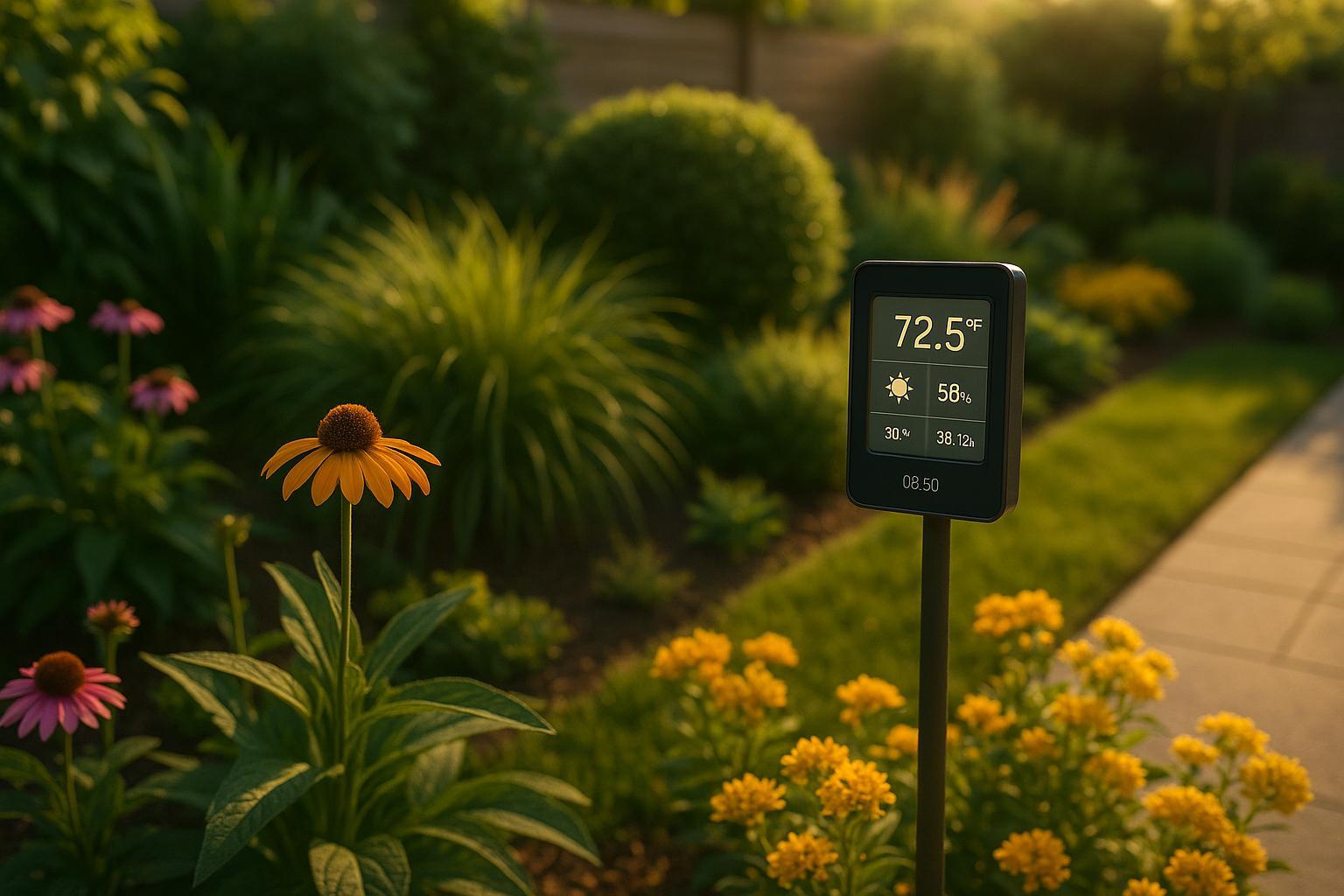
Solving Temperature Fluctuations with AI Tools
Explore how AI tools are revolutionizing garden management by monitoring temperatures, predicting weather, and optimizing plant care for better yields.
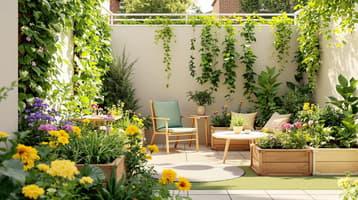
Small Garden Design: 10 Tips to Maximize Limited Space
Transform your small garden into a functional, inviting space with tips on vertical gardening, space-saving furniture, and strategic plant choices.
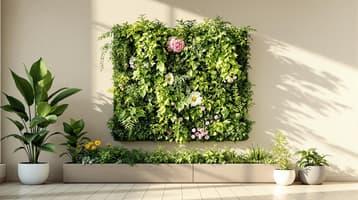
AI Tools for Designing Vertical Plant Combinations
AI tools streamline vertical garden design by optimizing plant selection, layout, and maintenance, making gardening accessible for everyone.
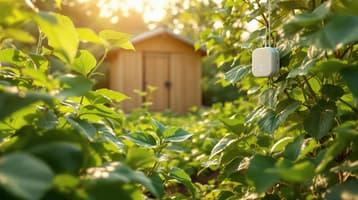
IoT Security for Garden Sensors: Key Features
Learn how to secure your IoT garden sensors with encryption, access controls, and network protection to safeguard your garden's data.

15 Low-Maintenance Plants for Busy Homeowners
Explore 15 low-maintenance plants perfect for busy homeowners seeking greenery without the hassle of intensive care.